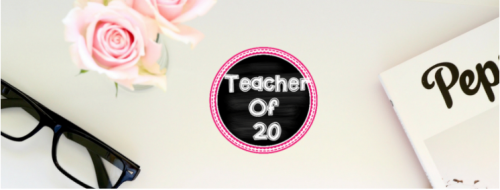As I mentioned, I am very familiar with the book The Daily
Five, and have been implementing it in my kinder classroom for several years
now. This year my goal is to expand on that by using the Café Book as a guide
on data collection for each student as well as to teach the metacognitive
strategies in the book for readers to monitor their reading. I have already set
up my binder, or Pensieve (as the book refers to it) the way it is described in
the book so it is ready to go for August! At the beginning of the binder is a class
list. In it the teacher marks what date she will meet with that student again.
This is a quick visual of how often I am meeting with each student. It will help
me keep track of students that I need to meet with everyday, as well as those
that may get forgotten about. It will give me information when the last time I
met with a high reader was, and if I should meet with that student again. Instead of names, I put numbers on the forms because it helps me maintain the confidentiality of students. Another form mentioned in the book that I chose not to use is the calendar. That is where you make appointments with students and meet with them on those days. I chose not to do this because in my classroom I have a schedule of groups that I meet with. I find that the schedule doesn't change from week to week. Ex: I meet with group 1 and 2 everyday. I meet with group 3 on MWF, and group 4 on T TH. There is a 15 minute block at the end of each day that I reserve for intervention, or enrichment groups. I will use the form below to monitor that block of time.
Behind the class list is a weekly lesson plan of the groups
I am meeting with (with each student name) and what goal and strategy
we are working on (an example of a strategy is Cross
Checking). Whenever a reading strategy is introduced,
it is added to the Café board under the goal it corresponds with (Comprehension, Accuracy,
Fluency, Expand Vocabulary). The book has a mini-lesson for introducing each strategy.
I have a numbered tab for each student, as seen in the first picture of this entry. Behind
each tab is a form for how each conference or guided reading group
meeting went for that individual student that day, and a section to document
what will be the strategy we work on of the next lesson based on student
performance in the current lesson. For
example, if a student is having a hard time with looking at the beginning sound
of a word to predict what it is, that will be the focus for the next lesson. The book includes a blank template, and one with icons to help you remember the sequencing of your lesson. I have not decided which form works best for me yet, so I made copies of both. As I begin note-taking, I will have a better feel for which form works best for me. Below you can find a picture of both:
This is what I've taken away from the Cafe Book that I would like to implement next year for my data collecting. I will update you on how student monitoring is going with this new system I will implement once school starts and I begin collecting my data!




Comments
Post a Comment